Mission Day 722: 15:15 hours
Unknown Ganymede station
Second Shift
At the bottom of the shaft, I was in complete darkness, although my eyes were adjusting slowly. Just as I wondered how I was going to get out of the car, its doors opened up and lights flickered on in a hallway in front of me. I got to my feet—steady, I thought. The gravity down here felt different from both the installation, and topside. I was just getting my bearings when I saw that there was only one button in the elevator car. Up when you’re down and down when you’re up, and you’d better have your spacesuit on, I thought. I threw the tire tool into the hallway, where it gently bounced against the metal floor.
My own suit’s power supply now dead, I unscrewed my helmet hoping there was breathable air here. I still didn’t have much choice. I’d know momentarily if there was, or I’d suffer decompression so severe that it would make the bends that divers back home get look like a mild case of the hiccups. Phsst! My helmet came off and I smelled fresh, clean air. It was warm—a little cooler than the installation had been, but the air here was more pure somehow. It didn’t smell of people. Even with atmospheric reprocessors and C02 scrubbers, you could still smell the farts and the dead skin cells that had flaked off of your crew. Here, there was none of that. It was clean, cold, clinical. And yet, there had to be somebody here. Why else the atmosphere? The elevator?
I stripped off my suit and crawled out, leaving my boots and jumpsuit on. I grabbed the plasma torch and headed down the hallway. Let’s see what there is to see, I thought. As I rounded the corner carefully, my mind began spinning through the options. It’s a control station. A monitoring station. That’s it. That’s got to be it. Just a once-in-a-while, mostly unmanned pit stop to check levels on tidal forces and moonquakes. Like the one we got hit with. Too convenient. This was obviously a permanent station, not built out of a kit like our installation was; our mining stations; our terraforming units. This was first.
The long hallway came to an end with a big drop at a T-junction. This must have been built on a natural ice cave, blasted out of the methane before our installation. I had learned in school that Ganymede is almost 52% larger than the diameter of the Moon and has twice its mass. It is 77% the diameter of Mars—but comprised of mostly ice and ores, it has such low density that its gravity makes it easy pickings. But why keep this station a secret?
I went to the edge, and looked over. My head was spinning. Even at one seventh G, it was a long way down. It got dark about twenty feet from the rail, and I could only imagine how far down it went. If I could see the other side, there was a chance I could run, launch off the rail, and grab the other side—if there even was one.
Thinking better of it, I explored the hallway perpendicular to the one I’d entered from. The walls here were made from much sterner stuff than our old installation; it looked to me like high-grade prefabbed aluminum, almost certainly with old style, heavy-duty radiation shielding behind it. The kind with lead, concrete and Mylar sandwiched together. But the floor was made to exactly the same specifications as ours. This made me angry. Some kind of secret program built here, first, and none of us knew about it. This place could have saved everybody I worked with. It could have saved the woman I loved. This didn’t feel like the Space Corps to me—somebody would have breathed a word of it to Devon, and he would have told the rest of us. This had to be the Company’s doing.
Someone wanted us out of the way. That was no rogue comet. They probably knew it was coming for months. The Jovian Deep Space Array would have detected it. I was becoming furious just thinking about it. Somebody purposefully wanted us dead.
I reached the end of the left-hand portion of the hallway. A big door. With little slits through it at the top like a high-school gym locker. Dark. No doorknob, no keypad, just a panel to the left of the door with a ducted ceramic indentation. Looked like a high dielectric coupling device, probably piezoelectric-acoustical wave. I obviously didn’t have a spherical key for that, so I doubled back, boots CLICKing, and went down the hall the other way at the T-junction and tried the other door. Not surprisingly, it was exactly the same. Returning to the hallway, I noticed that there was a similar control for something in the middle, this one had an additional interface with an indentation in it. It seemed as if there were an extendable bridge leading over the chasm of ice. I could see the end of it jutting out from the edge of the floor.
I was at an impasse. Fat lot of good being a class I mechanical/maintenance technician did me without any tools. Well, I got in, I thought, now I just have to get in further. If I couldn’t get inside those doors, I’d have to bring somebody out. It was too clean in here, like the clean rooms back at Space Corps. Somehow, I would have to make a mess and see who came out to clean it up. But with what? I thought about lighting my suit on fire with the plasma torch, but if I were ever to escape from here and make the Friday Run shuttle, I would need it to get back to our damaged installation. First I’d have to figure out a way to power it up. One thing at a time.
I went back down the hallway to the door to the left of the junction. A sensor above the door peered down at me that I’d missed before. I could damage it, I thought, with the tire tool or the plasma torch. But that was a trick I could only play once. Then it hit me. The water supply inside my suit. Unless I got power back into it, it wouldn’t recycle for long enough to last until Friday. But there was enough there to maybe short out that control panel.
I made my way back to the elevator where I’d left my suit, and grabbed the tire tool and water bottle out of it. There were secondary and tertiary backups, so this wouldn’t be the absolute end of my supply. I checked the greywater containers but there wasn’t enough there to do much with. I took a last, long pull from the water bottle—who knew when I’d get another primary source.
I squirted the remainder of the water onto the electro- mechanical coupling device and the control panel next to it. The panel sparked, as if it had shorted out. Then, nothing. My hopes were dashed. I had nothing left to affect the door with short of burning my suit. I sat down, frustrated. My anger at being a patsy to whoever had built this station was combined with a growing sadness at my inability to work my way further into whatever it was.
Just then, the large metal door opened silently. A mechanized robot floated out into the hall, repelling off of the metal floor somehow. It wasn’t huge, but it was intimidating; gunmetal grey with a sort of flower pot head and two arms—one with a spherical end! It had no legs, but hovered a few feet above the floor, moving with slow determination.
Wasting no time, I rolled just under the robot and into the small room it had come out of–the closing doors nearly clipped me as I pulled my feet through, getting only a piece of the tire tool that I was still holding onto. Rising to my feet, I could hear faint whirring and mechanical noises from inside the walls of the maintenance closet. It sounded like electronic music, repetitious and eerie.
I looked around, and although many controls and devices adorned the room, I could see no openings or doors from here that I could fit through save the one I’d just entered. Screens atop a ledge displayed machine data; there were waste chutes and refills for cleaning supplies, but no other ways out. That robot would be coming back soon, I thought. As soon as it’s dried the panel and worked out the short, it would come back and I did not want to have to fight a metal man when it did. And another thing—that robot looked like it used a linear induction motor for propulsion, like the kind used in maglev trains. That means I don’t want to touch it—it’s operating under extremely high voltage. And any minute, it would be crammed in here with me and I wouldn’t have any choice but to touch it. I’d have to incapacitate it without touching it.
One last good look around. Nothing. Nothing I could use. I looked down at the tire tool in my right hand. Nothing had ever seemed so clunky and useless. I was stuck alone in a maintenance closet with nothing but faint, creepy mechanical music to keep me company.
Then it struck me. In my training toward my mechanical engineering degree with the Company, I remember learning that the acoustical wave devices used in electromechanical coupling controls like that were subsonic. 20 Khz at best. There’s no way a human being could hear them. But those connectors—that’s all they could hear. This type of control was infrasonic.
So all I had to do was disable the robot without touching it, take its arm off, and play the appropriate sounds for the controls on that extendable bridge’s panel while coupling the arm to the spherical ducting.
I might as well still be outside, frozen to the surface, staring up at the Great Red Spot. Keep your mind in the game, I thought. You’re running out of time. I had passed underneath the robot without any ill effects; what if I could use its high voltage against it? Somehow stop it in its tracks. Something to get in the way of its propulsion.
That’s why the tire tool had hit the door on my way in—it wasn’t that I was too slow—it was being pulled back by the linear induction motor’s magnetic field. I knew what to do now. I placed the tire tool directly in front of the doors and stepped onto the ledge in front of the screens that were streaming mostly machine data, and the occasional external shot of Ganymede. Now all I had to do was wait.
Within seconds, the doors opened again, and the robot began gliding into the room. As it passed over the tire tool, it spun wildly in an upward spiral and struck the robot on the bottom of its housing with a loud, hideous, CLANG! The robot wobbled, spun out of control and fell to the ground, and when it hit, it powered down—shorted out between its own high voltage and the floor.
The doors could not close because the robot was solidly wedged between them. I unclipped the plasma torch from my jumpsuit and tossed it at the robot to make sure that it was no longer electrified. It struck the robot and fell to the ground harmlessly. I picked up the plasma torch, clipped it back on and got to work. I assumed the other maintenance closet had an identical robot and that it would be here as soon as it figured out its companion was down to come take care of it.
I applied the plasma torch to the end of the robot’s arm, near the join to the sphere at the end. It didn’t take long before the metal gave way and the end dropped to the floor. Hurriedly, I crawled over the robot, and went out to grab my water bottle. There was a little left in it, which was lucky. I scrambled back over the robot onto the ledge and squirted the remainder onto the hot slag end of the robot’s limb and left it to cool. Hopping over the dead hulk again, I landed with a bounce onto the metal floor and a CLICK—and ran for my life. The gravity here was definitely somehow different. Running was hard. It took a concerted effort of will not to tumble end over end.
As fast as I was able, I sprinted down the hallway to the T-junction, and indeed, there was a robot identical to the one I had just disabled, just clearing the other corner. I raced to my suit, grabbed my helmet and made a break back for the maintenance closet. We never had this much room to run in our old installation. I was glad that I’d continued working out after being on the track team back home. It was crucial to life on Ganymede. As it was, I beat the second robot as it closed the gap at the T-junction with little time to spare.
I returned to the maintenance closet, making my way over to the first, defunct robot. Its dead limb was hot to the touch, but not hot enough to burn me. I had only one chance to make this work. Hopping back over the robot, I landed on the floor and met the second robot about halfway down the corridor. Staying clear of its outstretched arms, I laid the first robot’s appendage in the way of the second. I had to hope that they didn’t communicate with one another.
But this one seemed savvier. Maybe it was that the first one couldn’t see the tire tool in front of the doors—but this one didn’t approach any further than about five feet from its twin’s metal hand. It backed up, tried to make another approach, and then backed away again. It hovered there, menacingly, blocking my exit from this side of the hallway.
I didn’t know what else to do, so I put on my helmet, and made my way over the fallen robot back into the maintenance room. I could still hear the faint whirring and creepy musical sounds emanating from the room. I hoped that the infrasonic decoupler was still active and transmitting inside the door, which was still unable to close around its keeper.
Now, a bit more calmly, I removed the helmet and pointed its internal microphone at the control panel. Using the com recorder inside my helmet, I hoped I was recording the signal that would activate the extendable bridge at the T-junction—if I could just get past metal-head out there.

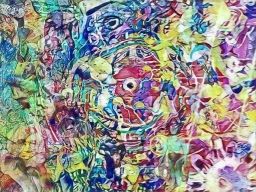
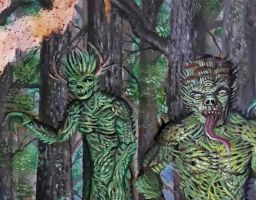

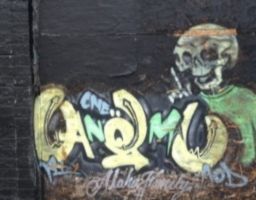
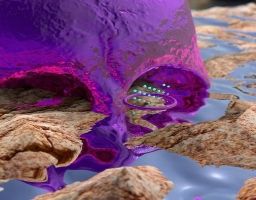
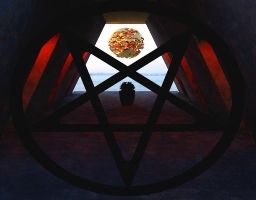

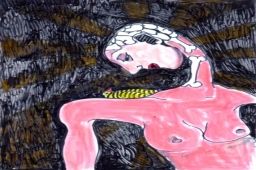

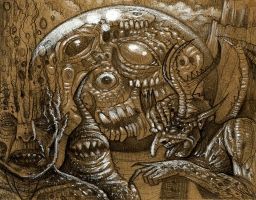
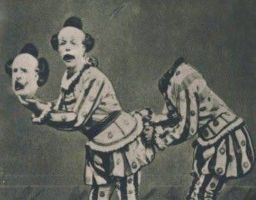
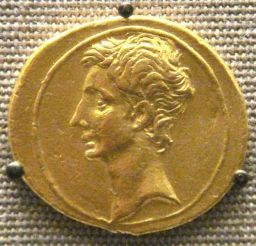
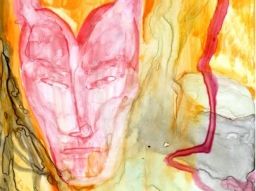



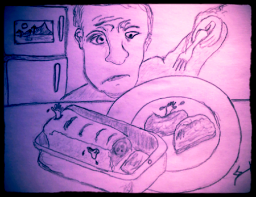
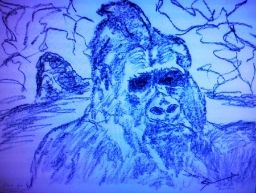
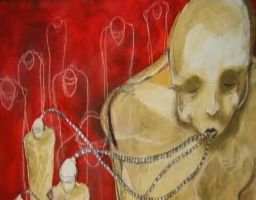
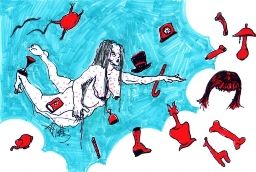

GREAT stuff, Shaun! How many more chapters can there be? And the art before every one is _perfect_ for this story. Such a labor of love, like I've never seen before.
ReplyDelete